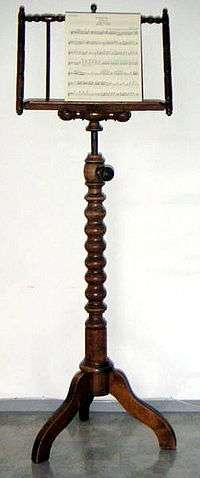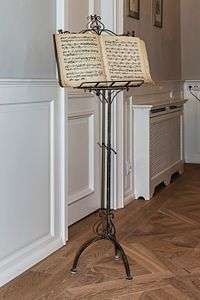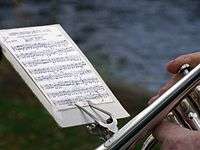Music stand

A music stand is a pedestal or elevated rack designed to hold a paper score or sheets of music in position for reading.[1] Most music stands for orchestral, chamber music or solo orchestra-family instruments (violin, oboe, trumpet, etc.) can be raised or lowered to accommodate seated or standing performers or performers of different heights. Many types of keyboard instruments have a built-in or removable music rack or stand where sheet music can be placed. Music stands enable musicians to read sheet music or scores while playing an instrument or conducting, as it leaves the hands free. Music stands are sometimes used by singers, but for choirs, singers typically hold their sheet music in a folder and singers doing solo recitals or opera performances typically memorize the lyrics and melodies.
Types
There are various types of music stands for different purposes.
Folding
Lightweight
Folding stands range from inexpensive, lightweight models made of metal, which are designed to hold a few pages of sheet music or a thin songbook, to stronger, more expensive heavy-duty models. Metal folding stands often have solid wire extensions or metal "arms" which can be folded out to support more than two pages of music or over-size sheets or pages. This is the kind most often used by music students. Lightweight folding stands are designed to be easily portable, so that they can be taken to rehearsals, auditions and performances. Lightweight stands are not designed to support heavy books of music such as full-size fake books; while the fake book may stay open on the stand, the music stand may fall over. Folding stands consist of a rack for the music and a telescoping cylindrical column for supporting the rack, with screws or other fastening devices to secure the extended columns at the desired height. Folding stands typically have a foldable tripod that supports the column and the music shelf. The rack area for holding the music is either pre-set at a slight incline away from the performer (as compared with being straight up), so that a song book or étude book will lie open naturally, or the degree of incline can be adjusted by the performer (on more expensive stands).
The portability of lightweight music stands can lead to some problems. Heavy fake books or full scores may overload the stand, leading to it falling over when a performer turns a page. As well, when a lightweight stand is used with its column fully extended, as by a standing orchestral timpanist or double bass player, a heavy part may be "tippy" on the over-extended column. Oversized parts, which are used in some contemporary classical music, may be too wide to be supported by the stand; a solution that some musicians use is to use multiple stands for oversize parts. As well, during outdoor performances, such as playing at a wedding, picnic or a bandstand, lightweight stands may be blown over by wind, which can interrupt a performance or even, if the stand strikes an instrument, damage the finish of an instrument.
Heavy duty
Heavy duty models typically use a hollow cylindrical column as the main support and three cylindrical columns arrayed in a tripod to ensure the stand stays upright. Heavy duty stands can reliably support a thick, several hundred page fake book, song book or a binder full of songs. The height of the column can be raised or lowered to permit the stand to be used for a seated performer (common for most orchestral instruments, except for percussion and sometimes double bass) or a standing performer. Amateur orchestras and some youth orchestras typically ask members to bring folding stands to rehearsals, and sometimes also to performances, as this saves the ensemble the cost of buying or renting, and transporting one or more racks of non-portable stands.
Non-folding
Professional orchestras, concert bands and big bands typically use non-portable, non-folding heavy-duty stands. The stands are typically coloured or painted black so that the stands blend in with the black clothing of the musicians and are not distracting. The music holding portion of the stand may be plastic or metal, and in both cases, the music holding portion is supported by a metal column. The part supporting the music often has a shelf below it for pencils, rosin (for string players), and other rehearsal accessories. The metal column can be raised or lowered to put the stand at the desired height. Professional stands can be lowered to be used for a seated performer or raised for standing performers.
The statement that these stands are "non-portable" refers to the fact that these stands do not fold or collapse and are thus rarely used by musicians travelling alone or one-by-one to rehearsals or gigs. The stands can be moved, of course, but for a full orchestra to move its 50-100 stands, which are often loaded onto a heavy rack, a moving truck and movers need to be hired to relocate the stands. Professional stands either have some type of tripod-style or quadruped-style base, or they have a heavy, metal cylinder.
Some musicians use non-folding, professional stands for all of their rehearsals and gigs, even though this may require them to take more trips to load their gear into the hall. The reason some musicians choose to use non-folding stands is because they are more stable, even with heavy parts or scores, they are more resistant to falling over during outdoor shows, and they look more professional. As well, some performers like to have access to a shelf underneath their stand, to obtain music accessories that are needed throughout a rehearsal or show (e.g., pencils, rosin for string players, picks for guitar players, reeds for reed players, valve oil for brass players, a tuning key for percussionists, etc.)
Musicians may also have expensive non-folding stands in their homes or music studios made of wood or metal. These stands are not designs that are meant to be relocated. Due to their weight and/or their delicate finishes, they are intended to be used in a single location, such as a private home. Some heavy stands are made of carved wood and feature bas relief carvings and inlay work. Other heavy stands are made of brass, and feature musical motifs such as treble clefs. Some of these heavy stands are objects of art in their own right.

Digital
Digital music stands that use a computer screen to display the music began being used in the 1990s and 2000s. The digital "pages" can be turned by pressing an electronic footpedal, thus enabling performers to play chamber music or solo pieces with difficult page turns without hiring or finding a volunteer to act as a page turner. The music notation is typically displayed on a flatscreen display or a tablet computer screen.
Marching band

Marching band or some brass band members use a small sheet holder called a lyre or a clip which, can be attached to an instrument. The clip holds a smaller-sized part for the performer, so she/he can read the music while marching.
Conducting
Large, heavy duty music stands are available for conductors of orchestras, concert bands, choirs and big bands to hold their heavy, over-size scores of music. These stands are typically not designed to be easily transportable, and they are usually intended for installation in a rehearsal hall or concert hall. Conductor's stands have to be able to be angled much flatter than an instrumentalist's stand, because the conductor reads from a large full-score, which contains the parts for all of the instruments. For some symphonies, the score can be both thick and heavy; to ensure that the stand is stable, a conducting stand needs to have a heavy, wide base and a sturdy platform for the score. As with professional instrumentalist stands, some conducting stands have a narrow shelf where a conductor can store her batons, handkerchiefs, reading glasses, and, for rehearsals, a small metronome.
Keyboard instruments
Upright pianos, grand pianos, stage pianos, harpsichords, pipe organs, Hammond organs and many post-1980s electronic keyboards have some type of rack or stand to hold sheet music and/or scores. On some grand pianos, the music stand can be removed, for example, if the performer is playing a piano solo work or a piano concerto from memory. On some electronic or electric keyboards, the stand can be removed, to facilitate transportation of the instrument to rehearsals and gigs. If the music stands on electronic and electric keyboards were permanently affixed, they would make the instrument harder to load into a van or car, and the stand would be vulnerable to damage.
On some digital pianos designed for use in a private home or studio, the music rack is permanently installed, but most users of digital pianos do not transport them to rehearsals and gigs, because these instruments often have a number of design features that are not conducive to regular transport (e.g., fixed keyboard legs and a modesty panel and fixed pedals for sustain and sostenuto). Most keyboardists who are regularly transporting electronic keyboards to rehearsals and gigs use stage pianos or MIDI controller keyboards along with a sound module; on these instruments, all of the accessories (music rack, keyboard stand, sustain pedal) can be disconnected. By enabling the keyboard to be broken down into separate components, it makes the instrument more transportable in a regular car, even including small vehicles. In contrast, a high-end digital piano with a fixed music rack, stand and pedals would need a van and several helpers to transport it.
Challenges
With outdoor performances, users of music stands can face challenges due to wind blowing the pages of sheet music off the stand or blowing the pages to an incorrect page. To resolve this challenge, performers use metal clips or clothes pins on the sides of the music or lay a sheet of plexiglass over the stand. While these methods prevent the music or pages from being blown by the wind, they make page turns more difficult.
History
American President Thomas Jefferson invented a revolving music stand.
Comparison with music desk
The term stand, as it is used to describe furniture such as a plant stand or music stand, generally implies a relatively small surface area supported at the required height, most usually by a turned leg or support known as a standard. Any inclined surface that can be used for supporting music may be thought of a music stand, although generally this function is divided between two types of furniture: a music stand proper and a music desk. The music stand, as the name suggests, consists of a support for the music raised upon a freestanding column or tripod, which, in addition to being movable may also be adjustable with regard to its height and the angle at which it may be tilted. A music desk generally implies a similar, tiltable support for the music, but rather than being raised on a stand, instead forms part of a table. In as much as the term "desk" originally implied a sloping-topped table for reading or writing, the slight adjustment necessary to turn a desk into a music desk was a relatively simple matter.
| Wikimedia Commons has media related to Music stands. |
References
- ↑ "Music stand". Dictionary.com. Retrieved 1 March 2016.